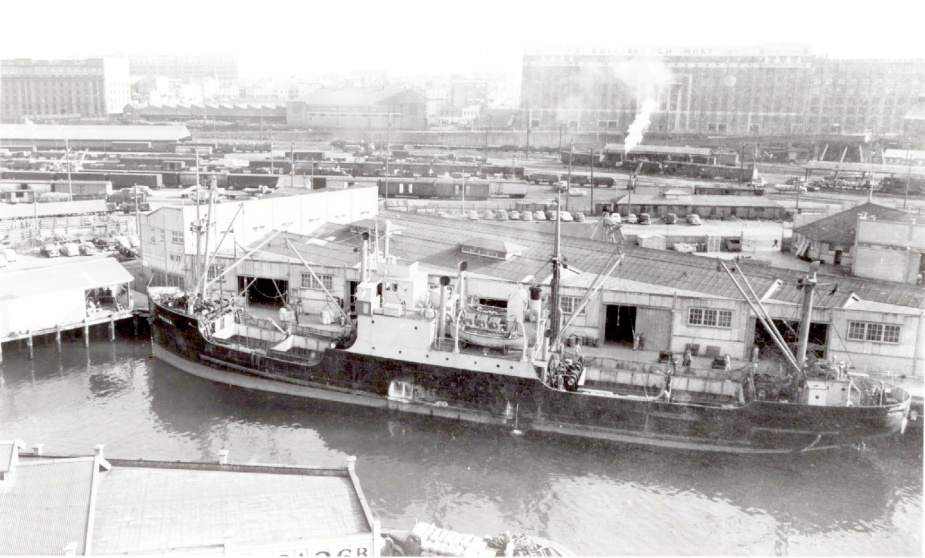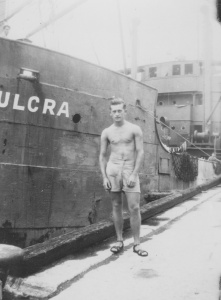MV Mulcra was built in Svendborg, Denmark in 1925 as an interstate cargo motor ship for the Adelaide Steamship Company.
On 13 November 1942 Mulcra was requisitioned for war service by the United States Army Transport Service as an armament stores carrier, serving in that capacity until 28 April 1945 when, in a war-weary state, she was handed over to the Royal Australian Navy (RAN). At that time she was described by her future Commanding Officer, Lieutenant FJ French, RANR (S), as follows:
The condition of the ship is not satisfactory. It is quite obvious that maintenance has been neglected over a considerable period. Rust scale is evident on all deck fittings, many of which on examination may prove to be unserviceable. The task of rectifying the results of such neglect is impossible with an ordinary working crew.
Another former crewman, Ordinary Signalman Brian O’Shannassy simply described her as a ‘rust bucket’. Regardless, Mulcra was pressed into service, commissioning in the RAN on 11 June 1945. Her crew worked hard to bring the ship up to a satisfactory standard and on 15 July she conducted full power trials off Sydney before briefly returning to port for defect rectification. Mulcra sailed later that day for Madang, New Guinea, having embarked four RAN ratings taking passage to join HMAS Poyang.
In the early hours of 16 July a fire broke out in the ship’s engine room when oil spilled over a hot exhaust pipe and ignited. Fortunately, the blaze was soon brought under control and there was no major damage reported. The voyage to New Guinea continued but was punctuated by engineering defects and rough weather which on one occasion forced Mulcra to ‘hove to’ for some 19 hours until the seas abated.
As weather conditions improved Mulcra continued her voyage, proceeding through the Jomard Passage on 23 July, arriving at Madang on 25 July. There she landed the Poyang ratings and began disembarking cargo before moving alongside HMAS Yunnan to transfer ammunition.
On 5 August Mulcra sailed for Langemak Bay, where she arrived the following day to take on cargo. Loading was completed on 8 August and the next day she sailed for Lae, where she berthed that evening. During unloading operations on 10 August the ship’s main electrical generator failed, restricting the ship’s ability to operate its winches and unload ammunition. A replacement unit was delivered by HMAS Bungaree on 13 August, and with the help of the Australian Army’s 1st Army Workshop and Water Transport Section the new generator was installed on the main deck and set to work. In the mean time Mulcra was restricted to using a single winch and swinging derrick to transfer ammunition to HMAS Diamantina (I). It was during this period that Mulcra’s crew learned of the ceasefire with Japan on 15 August.
Mulcra returned to Madang on 23 August, remaining in harbour until 8 September at which time she sailed for Torokina, Bougainville, with two RAN motor launches (ML 427 and ML 428) in tow. On 9 September the three vessels encountered rough weather off Finschafen causing the tow line to part. The two ML’s subsequently proceeded under their own power into Finschafen while Mulcra continued her voyage to Torokina arriving their on 12 September. The next three days were spent embarking ammunition before sailing to rendezvous with ML 427 and ML 428 at Doini Island. There, the two MLs were again taken in tow and a course set for Australia. Bad weather on 19 September again interrupted their progress when the towing bridle and chain in ML 427 was carried away. This forced the trio to seek shelter to effect repairs in Port Morsby which was reached the following day.
The voyage continued on 21 September but was again interrupted when Mulcra suffered a main engine failure. This necessitated anchoring over night in the lee of Manuba Island to carry out repairs. The next day, Mulcra reconnected the tow and resumed her southerly course, anchoring off Cairns, Queensland, on the evening of 26 September. The following morning she entered harbour and secured alongside
Smith’s Creek Wharf where the crew commenced loading ammunition destined for Brisbane and Sydney.
Mulcra’s engineering problems continued to delay proceedings when it was found that the ship’s secondary generator could not produce sufficient starting air for the main engines. The next three days were spent running high pressure air piping from the temporary deck generator to the engine room to remedy the problem. Following a successful trial, the ship got underway on 11 October and proceeded to sea where she again took the two MLs in tow bound for Brisbane.
The passage to Brisbane was without incident and the two MLs were slipped on 16 October. Mulcra then proceeded to anchor before securing alongside the Railway Wharf at Pinkenba. Several shifts in berth followed over the following week during which time Mulcra’s cargo was discharged and a southbound cargo embarked.
On 1 November Mulcra was secured alongside Musgrave Wharf, Brisbane. Over the following two weeks a variety of cargo was embarked before the ship sailed in company with HMAS Martindale (for Sydney) with Harbour Defence Motor Launch (HDML) 1074 in tow.
On reaching Sydney Heads early in the morning of 20 November (again in the grip of adverse weather) Martindale was detached to proceed independently into port, leaving Mulcra to continue with HDML 1074.
Mulcra passed through the Heads at 0545K and was met by the Pilot Steamer Captain Cook which attempted to pass astern of Mulcra, parting her tow line and colliding with HDML 1074. The ships subsequently went to anchor where an inspection revealed that damage to both vessels was slight. The towing bridle and cable were lost.
The following day Mulcra shifted to Walsh Bay where unloading commenced on the morning of 22 November.
On 3 December Mulcra slipped from Walsh Bay and moved to the Adelaide Steam Ship Company berth at Number 6, Darling Harbour. There, the ship’s naval stores, confidential books, ready-use magazines and wartime armament were landed in preparation for the ships eventual return to her owners. The next four days were spent embarking a commercial cargo.
With her cargo embarked the war weary Mulcra sailed for Port Adelaide on the morning of 8 December on what would be her final voyage as a ship of the RAN. The passage to South Australia was plagued with main engine breakdowns and on her arrival on 14 December 1945 the engines failed completely. It was only with the assistance of a tug that she reached her final berth.
The New Year found Mulcra lying at the Naval Wharf, ‘D’ Berth, in Port Adelaide where work consisted of dismantling and returning all remaining Naval property to stores. Officials and workmen of the Adelaide Steamship Company inspected the ship and began making arrangements for docking and overhaul prior to putting the vessel back into commercial service.
The demobilization of the ship’s company followed and was completed on 10 January 1946 at which time HMAS Mulcra decommissioned (without fanfare) and was handed back to her owners having steamed 6896nm on war service with the RAN.
Following the war Mulcra returned to trade until 1961 when she was sold by the Adelaide Steamship Company to Hong Kong buyers and renamed La Trinidad. In 1964, under Panamanian registration, she was trading as Tasanee and later as Andes and Veng-An. She was scrapped in 1976.
Specifications
 |
| Type |
Armament Stores Carrier |
|---|---|
| Pennant |
S-141 |
| Builder |
Svendborg, Denmark |
| Commissioned |
11 June 1945 |
| Decommissioned |
10 January 1946 |
| Dimensions & Displacement | |
| Displacement | 1200 tons |
| Length | 215 feet 8 inches |
| Beam | 34 feet 2 inches |
| Draught | 14 feet 10 inches |
| Performance | |
| Speed | 10 knots |
| Complement | |
| Crew | 47 |
| Propulsion | |
| Machinery | Diesel engines |
| Armament | |
| Guns |
|


